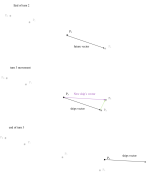AnotherDilbert
SOC-14 1K
I have no idea what you mean.On the playing surface you have to track displacement because you have to know where stuff is so they can interact.
If you plot velocity vector then you can not get range to target without doing a bit of maths.
The position of the dot or miniature representing the ships gives us the range, we can physically measure it on the playing surface, without involving any vectors at all.
The ship's vector (originating in the ship's position, pointing at the future) is its velocity. The vector is not involved in measuring the current range. The vector shows what will happen next movement phase, barring any acceleration.
It's explicit in LBB2:
A burn of 1 G for 1 turn = 10 m/s² for 1000 s = 10 000 m/s = 10 km/s, it's a velocity change, acceleration.LBB2'81, p26, "Basic Parameters":
_ _ 3. Thrust: Maneuver drive thrust is measured in Gs (gravities) expressed as a vector of both length and direction. While direction is variable, the length of the arrow is represented at the scale 100 mm equals 1 G (1,000 seconds acceleration at 1 G will produce a velocity change of 10,000 km, or 100 mm in scale, per turn).
The resulting vector is 10 000 km/turn = 10 000km/1 000 s = 10 km/s, it's a velocity.
Without any other acceleration the ship will travel the same 10 000 km/turn, every turn, forever. The ship's position will change every turn, the vector (the velocity) will move with the ship, but remain constant length and direction.
A basic application of Newton's Laws of Motion.
I have no idea what of the above you disagree with, but it must be something, probably fundamental. Please enlighten me?
Last edited:





